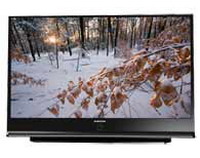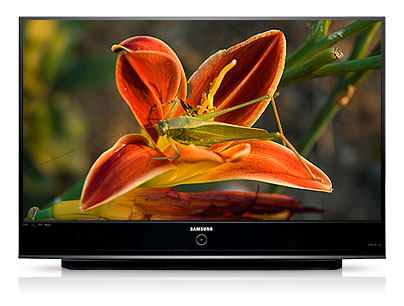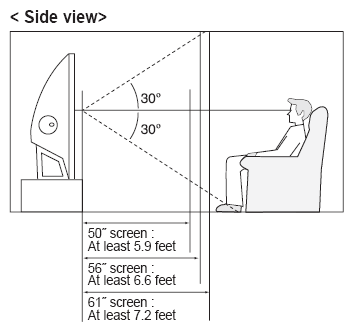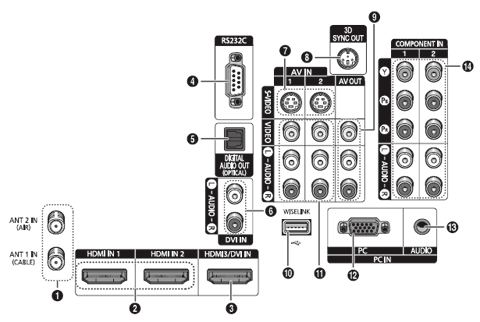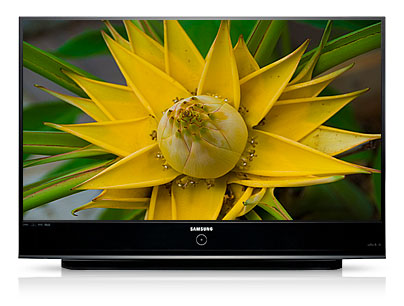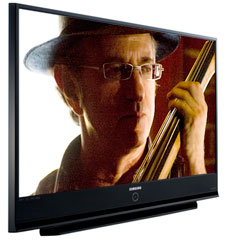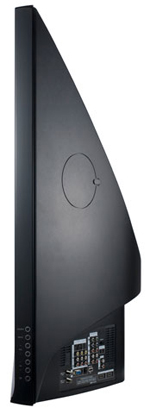
|
|
 |

|


Dick De Jong November 8, 2007 HDTV Solutions The Samsung HL-T5689S provides a perfect example of why you don't judge a book by its cover. This 56" HDTV is an RPTV - or as they like to be called nowadays, a microdisplay TV. The RP stands for the rear projection system that is the guts of the TV. But if you look at the back of the unit, RP could as easily mean its rear is projecting. I will admit it, I'm biased. When it comes to HDTVs, I believe that thin is in. Chunky and clunky, that's my first impression of an RPTV with its telltale caboose. But when I watched the World Series on this 1080p Samsung, I quickly appreciated what beauty this beast possessed inside of it. On further introspection, I also realized that the Texas Instruments DLP chip that drives this light engine is exactly the type of technology that excites the readers on our sister site, Projector Central. If you factor in the LED light source, clearly the HL-T5689S is not your stereotypical RPTV. And to erase any vestiges of fuddy-duddyness, the HL-5689S (and all of Samsung's 2007 DLP TVs) can display 3D content, which was definitely one of the coolest demonstrations at CEDIA this year. This feature-laden TV even includes Bluetooth connectivity for headsets and printers. [Editor's note: Samsung also makes a 50" model, the HL-T5089S, and a 61" HL-T6189S. Since they have the same specifications as this 56", the review can be applied to all three.] Out of the Box
And for all the fat aspersions that I cast its direction, the HL-T5689S is only fourteen inches deep, which is svelte for microdisplays. And from the front, with its 5/8" piano black bezel, it cuts a dashing figure. This HDTV is not made for wall mounting. In fact, the manual suggests that you place it at least four inches away from the wall to aid in ventilation. I don't think you would want to wall mount it anyway because to be at the optimum viewing angle, it would be placed about two feet off the ground. (That's based on eye height at the center of the screen, sitting in a chair or sofa. You can pull out the tape measure and calculate for your viewing situation.)
Also, as you see from the illustration from the manual, Samsung suggests sitting at least six and a half feet away from this 56" model. I'm normally a sit-as-close-as-I-possibly-can TV watcher. But when I was sitting maybe three feet away from this DLP, I perceived a bright band when dark content was on the screen. Moving back to the suggested distance solved the unevenness.
Since we are discussing viewing angles, I have included the manual's guidelines for seating off center. From my tests, 70 degrees may be a bit liberal. Interestingly, with microdisplays, the problem with moving too far off center is that the image becomes darker. With LCDs, the display tends to washout. I would plan on fitting your Super Bowl party guests within about a 100 degree wedge (50 on each side of the center line). The HL-T5689S does not swivel on its stand. The connector panel is within fairly accessible reach on the back on the right side. It houses all of the plugs that we have come to expect, plus a couple of extras. To begin, there are three HDMI inputs. The third is paired with stereo Audio Ins. The two Component inputs (YPbPr) also have matching stereo Audio Ins, as do the two Composite. Rounding out the crew are two S-Video Ins, a VGA connector with a stereo audio minijack for PC input, (though you also could attach your PC with a DVI to HDMI cable), an SPDIF (optical) digital Audio Out and a Service port (RS232C).
A closer inspection reveals some goodies nestled in amongst the usual crowd. For example, the 3D Sync Out is where you connect to a 3D IR Emitter, which sends signals to the special 3D glasses that you wear to see the 3D content on the TV. Also the Wiselink input is Samsung's branding of a USB port where you can connect a USB mass storage device to view photo files (JPEG) and play audio files (MP3). Lastly, the two RF antenna inputs are the links to the integrated NTSC/ATSC/QAM tuners. Since the tuner system is Clear QAM compatible, you can attach your cable TV signal directly into Ant 1 In and tune in unscrambled cable stations. Ant 2 In is for an external antenna.
The remote control is thinner than most other multi-function ones. You can backlight the Volume and Channel keys by pushing the little yellow light bulb button. Of course, you may be pondering, if it is so dark that you need to light up the buttons, then how are you going to see the light bulb button to begin with? Hmm... The remote provides buttons to directly access features like Picture Mode and Sound Mode. I would prefer individual keys for sources like HDMI, Antenna, and Component Inputs, but I guess the designers are saving real estate by giving just a general Source button that takes you to a drop down list of inputs. With only one tuner built-in, the Picture in Picture function is limited in the number of possible combinations. For example, you cannot watch two analog TV channels at once. The only available pairings are one analog TV broadcast and one source from an external device coming through an HDMI, Component, or PC input. Setup The Picture Mode presets are Dynamic, Standard, and Movie. I was not surprised to find the Default was Dynamic, which is too bright and contrasty for my staid eyes. We switched to Standard for our jumping in point. The Picture Menu provides the basic controls: Contrast, Brightness, Color (Saturation), Sharpness and Tint (Hue). Tint is labeled Tint (G/R), which describes the layout of that slider, from more green to more red. The Color Temperature selections are stored in a Color Tone sub-menu with choices ranging from Cool2, Cool1, Normal, Warm1, and Warm2. We began in the middle of the road, Normal. Beyond the basics, this Samsung gives you enough tweaks to make even the most dedicated videophile ecstatic. For example, the Detailed Settings section contains controls for Black Adjust, Dynamic Contrast, Gamma, White Balance, Edge Enhancement, and xvYCC. Perhaps my favorite label is called My Color Control with Pink, Green, and Blue sliders. As you can imagine, the options can be dizzying but with a little time and effort, you can dial in almost any color or shade of picture.
After adjusting basic color and contrast to suit my eye, I decided to play with the Picture Mode presets. Quite unexpectedly, I found that Movie mode exhibited a different but still quite pleasing image. Usually Movie is too dark and murky for me. This one wasn't. Fueled by that discovery, I began experimenting with some of the other settings that I usually turn off to begin with. I really liked how Samsung presents the DNIe (Digital Natural Image engine) feature. In the menu, you can set DNIe to Demo and then view side by side images of what the picture looks like with or without DNIe applied. I am not a big fan of these acronym features, but in this case, DNIe did improve the picture quality. Performance With the HL-T5689S, the visual buffet begins with a big colorful 1080p picture. Dare I say, with some programs almost too large and detailed - almost. Take the World Series for example, broadcast in glorious HD. I swear that if I were a connoisseur of chewing tobacco, I would have been able to identify the specific brand of chaw those players were expectorating all over the dugout.
Of course a screen this size is made for sports programming and this Samsung doesn't disappoint. But this display is nimble enough to handle most any type of content you throw at it. I'm watching a Blu-ray disc of Dave Matthews and Tim Reynolds Live at Radio City and the curved walls of that grand old venue shimmer with rich color. I also just tested it with the HD-DVD of What Dreams May Come and it reproduced the Technicolor heaven with aplomb. My congratulations to those hardworking two million little mirrors in that DLP chip. For the gamer, Gears of War on a four and a half foot screen is gut splattering explosive. The HL-T5689S provides a Game mode with Adventure, Sports, and Standard options. This TV does accept 1080p signals through its VGA input, which is a definite plus if you have a VGA cable for your Xbox 360.
Before I wrap this up, let me say a few words about the 3D feature. I can only be brief because I was never sent material to test it out. I did see it at CEDIA and can report that the 3D effect was palpable. I don't know how comfortable it would be to wear those 3D glasses for an extended time. But for the ten minute demo that included a test clip from an early Star Wars movie, I didn't mind since I was distracted by all the objects flying past my head. I think the technology of displaying 3D content has matured. The fly in the ointment is the playback device. Currently, there is no commercial 3D DVD player. Right now, you need to play the 3D program from a PC, which is connected to the TV with a DVI to HDMI cable. You then set the Samsung to the DLP 3D/Dual View and attach the 3D emitter to communicate with the glasses. It sounds fairly straightforward. If I have a chance to test it, I will update you. Samsung did announce at CEDIA that they are preparing a 3D starter packet that will include at least one set of glasses with the emitter and a few sample 3D games. They were estimating a price around $200 for the package. Finally, with a TV this large, you would hope that the sound system would match its stature. But alas the SRS Tru-Surround technology can only go so far in expanding the sound of the integrated ten watt stereo speakers. The audio quality is definitely good enough for a basketball game, but if you want to enjoy Dave Matthews in full video and audio splendor, treat your ears to a dedicated audio system. Conclusion
First, realize, that ratings are relative to when the review was written. The obvious example is Value, what you could purchase for $2000 two years ago or even two months ago would seem like a bad value for that price now. Second, we have given only a precious few 5 Star ratings, which we reserve for truly outstanding accomplishment. Performance: 4.5 Features: 5.0 Ease of Use: 4.5 Value: 4.5 |
Bookmark:
![]() del.icio.us
del.icio.us
![]() Reddit
Reddit
![]() Google
Google
| Send this Page | Print this Page | Report Errors |




